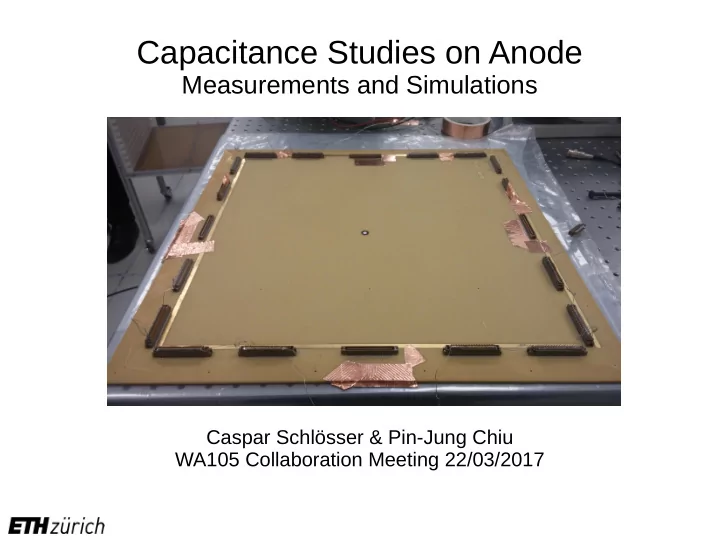

Capacitance Studies on Anode Measurements and Simulations Caspar Schlösser & Pin-Jung Chiu WA105 Collaboration Meeting 22/03/2017
Goal Capacitance studies of the anode: ● Measurements: capacitance measurements with LCR meter ● Simulations: capacitance simulations to model the anode and cross check with the results from the measurements Outline 1. Motivation → Pulsing measurements 2. Measurements with LCR meter 3. Simulations with a simplified model 4. Equivalent circuit studies WA105 Collaboration Meeting 2
Pulsing Measurements WA105 Collaboration Meeting 3
Pulsing measurements ● pulsing took place before Christmas last year ● 32 channels were pulsed simultaneously with 150 ≜ mV through a 1 pF capacitor 150 pC charge One connector pulsed WA105 Collaboration Meeting 4
Pulsing measurements ● pulsing took place before Christmas last year ● 32 channels were pulsed simultaneously with 150 mV through a 1 pF capacitor ≜ 150 pC charge ● pulse shape: square wave with, frequency ~3 Hz, 50% duty cycle, rise/fall times ~100 ns rise/fall times: ~100 ns Period: ~0.3 s Event viewer time window WA105 Collaboration Meeting 5
Pulsing measurements ● Noise reduction: cuts in Fourier space for f > 0.5 MHz view 0 32 pulsed channels in view 1 view 1 WA105 Collaboration Meeting 6
Pulsing measurements zoom Induced signal on other channels 32 pulsed channels in view 1 view 0 view 1 WA105 Collaboration Meeting 7
Pulsing measurements ● induced signal on other channels: ~ 1.6-7.6 % ● only small dependence on distance of non-pulsed channel to pulsed channel or view (parallel or perpendicular) 767 ADC counts WA105 Collaboration Meeting 8
Measurements with LCR meter WA105 Collaboration Meeting 9
Measurement Setup Cross-Talk Capacitance Study between any of the two strips and all LCR meter the others are connected to ground (ground terminal of the LCR meter for a Ground of reference ground). LCR meter Anode back Anode strip (measured strips in blue; else in red) Capacitance All strips are to ground connected to the anode back strip LCR meter and the anode back strip is left floating. Capacitance Ground of measured between LCR meter 1 strip and the Anode back ground. Anode strip (measured strips in blue; else in red) WA105 Collaboration Meeting 10
Cross Talk Study – Strip-to-strip parallel capacitance Strip-to-strip parallel capacitance decreases rapidly with distance Capacitance measured between parallel strips with varying distance Measurement conditions: All other strips grounded Humidity: 39.8 % on both ends Temperature: 19.4 °C WA105 Collaboration Meeting 11
Cross Talk Study – Strip-to-strip perpendicular capacitance Comparison to capacitance between parallel strips: Very similar capacitance measured between all combinations of perpendicular strips Capacitance measured between perpendicular strips middle edge Measurement conditions: Humidity: 39.8 % All other strips grounded Temperature: 19.4 °C on both ends WA105 Collaboration Meeting 12
Capacitance to ground Capacitance measured between 1 strip and ground Capacitance to ground ~ 78 pF All other strips are connected to the anode back strip and the anode back strip is left floating WA105 Collaboration Meeting 13
Simulations with a Simplified Model WA105 Collaboration Meeting 14
Capacitance Matrix ● Anode consisting of parallel/perpendicular strips acts like a capacitor. ● From the pulsing measurement, ~1.6 – 7.6 % signal on other strips were observed. ● To understand the interference between any of the two strips, the capacitance matrix is introduced. ● Diagonal elements: capacitance between one strip and all the others (total capacitance). ● Off-diagonal elements: capacitance between any of the two strips. WA105 Collaboration Meeting 15
Simplified Model in Simulation In the measurement of 50x50 cm 2 PCB, there are 160 strips in each view. ● For simplicity in simulation, a simplified model with 12 strips were used, ● and linearly calculated to 160 strips to cross check with the results from the measurement. y1 y12 x1 x12 To replicate the measurement, 1V is applied to 1 y1 strip and all the others are set to ground. Capacitance matrix contains all the 12 strips in x view and the 12 strips in y view. With this matrix, capacitance between parallel and perpendicular strips can be obtained. x12 y7 y8 y9 y10 y11 y12 x1 x2 x3x4 x5 x6x7 x8 x9 x10 y2 y3 y4 y5 y6 y1 x11 x12 3D geometry WA105 Collaboration Meeting 16
Results from Simulations and Measurements 1 strip and closest parallel perpendicular ground strips strips Result from 41.83 pF 3.34 pF 0.22 pF simulation Result from 78 pF 7.6 pF 0.5 pF measurement Simulations with different configurations are in progress, e.g. keep the other strips floating. WA105 Collaboration Meeting 17
Equivalent circuit studies WA105 Collaboration Meeting 18
Equivalent circuit studies ● simulation of equivalent circuit of multiple anode strips ongoing ● Goal: compare simulated induced signals to the ones observed during pulsing of anode WA105 Collaboration Meeting 19
Conclusion ● Capacitance measurements: ➔ Capacitance between parallel strips decreases rapidly with distance→capacitance between 3 rd closest strips (0.5 pF) less than 10% of closest strips (7.6 pF). ➔ Capacitance between perpendicular strips (0.5 pF) ~10% of closest parallel capacitance (7.6 pF). Each strip couples to 160 perpendicular strips. ➔ Capacitance to ground ~ 78 pF. ● Capacitance simulations: ➔ We were able to model the anode and have a preliminary understanding. Different configurations are in progress. WA105 Collaboration Meeting 20
Recommend
More recommend